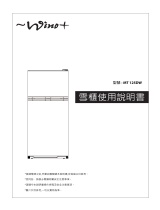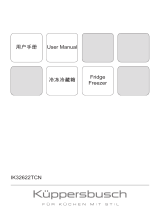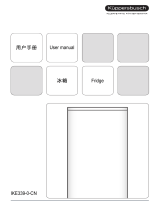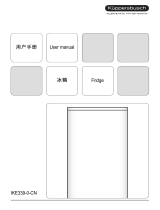
GB
FRIDGE
Contents
Installation, 2
Positioning and connection
Description of the appliance, 3
Overall view
Start-up and use, 4
Starting the appliance
Setting the temperature
Using the refrigerator to its full potential
Maintenance and care, 5
Switching the appliance off
Cleaning the appliance
Avoiding mould and unpleasant odours
Defrosting the appliance
Replacing the light bulb
Precautions and tips, 6
General safety
Disposal
Respecting and conserving the environment
Troubleshooting, 7
Assistance, 8
Operating Instructions
English, 1
GB
CN
Chinese,9
BTS 1621 CN

2
GB
Installation
! Before placing your new appliance into operation
please read these operating instructions carefully.
They contain important information for safe use, for
installation and for care of the appliance.
! Please keep these operating instructions for future
reference. Pass them on to possible new owners of the
appliance.
Positioning and connection
Positioning
1. Place the appliance in a well-ventilated humidity-
free room.
2. Do not obstruct the rear fan grills. The compressor
and condenser give off heat and require good
ventilation to operate correctly and save energy.
3. Ensure the appliance is away from any sources of
heat (direct sunlight, electric stove, etc.).
Electrical connections
After the appliance has been transported, carefully
place it vertically and wait at least 3 hours before
connecting it to the electricity mains. Before inserting
the plug into the electrical socket ensure the following:
• The appliance is earthed and the plug is compliant
with the law.
• The socket can withstand the maximum power of the
appliance, which is indicated on the data plate
located on the bottom left side of the fridge (e.g. 150
W).
• The voltage must be in the range between the
values indicated on the data plate located on the
bottom left side (e.g. 220-240V).
• The socket is compatible with the plug of the
appliance.
If the socket is incompatible with the plug, ask an
authorised technician to replace it (
see Assistance
).
Do not use extension cords or multiple sockets.
! Once the appliance has been installed, the power
supply cable and the electrical socket must be easily
accessible.
! The cable must not be bent or compressed.
! The cable must be checked regularly and replaced
by authorised technicians only (see Assistance).
! The manufacturer declines any liability should
these safety measures not be observed.

GB
3
Description of the
appliance
Overall view
The instructions contained in this manual are applicable to different model refrigerators. The diagrams may not
directly represent the appliance purchased. For more complex features, consult the following pages.
Removable lidded
shelf with EGG
TRAY
*
HINGED shelf
*
Compartment for a 2
LITRE BOTTLE
BOTTLE shelf
SHELVES•
FRUIT and
VEGETABLE
crisper
• Varies by number and/or position.
*
Available only on certain models.
TEMPERATURE
control

4
GB
Start-up and use
Starting the appliance
! Before starting the appliance, follow the
installation instructions (
see Installation
).
! Before connecting the appliance, clean the
compartments and accessories well with lukewarm
water and bicarbonate.
1. Insert the plug into the socket and ensure that the
internal light illuminates.
2. Turn the TEMPERATURE ADJUSTMENT knob to an
average value. After a few hours you will be able to
put food in the refrigerator.
Setting the temperature
The temperature inside the refrigerator compartment
automatically adjusts itself according to the position of
the thermostat knob.
1 = warmest 5 = coldest
We recommend, however, a medium position.
The cooling section of the refrigerator is located inside
the back wall of the refrigerator compartment for
increased space and improved aesthetics. During
operation, the back wall will be covered in frost or water
droplets depending on whether the compressor is
operating or paused. Do not worry, the refrigerator is
functioning normally.
If the TEMPERATURE ADJUSTMENT knob has been set
on high values with large quantities of food and with a
high ambient temperature, the appliance can operate
continuously, resulting in excessive frost formation and
excessive energy consumption: compensate for this by
shifting the knob towards lower values (defrosting will
occur automatically).
In static appliances, the air circulates in a natural way:
the colder air tends to move downwards as it is heavier.
The food should be stored as follows:
Food
Arrangement inside the
refrigerator
Fresh fish and meat
Above the fruit and vegetable
bins
Fresh cheese
Above the fruit and vegetable
bins
Cooked food On any shelf
Salami, bread loaf,
chocolate
On any shelf
Fruit and vegetables In the fruit and vegetable bins
Eggs On the shelf provided
Butter and margarine On the shelf provided
Bottles, drinks, milk On the shelf provided
1
2
SHELVES: with or without grill.
Due to the special guides the
shelves are removable and the
height is adjustable (
see
diagram
), allowing easy storage
of large containers and food.
Height can be adjusted without
complete removal of the shelf.
TEMPERATURE Indicator light: to identify the
coldest area in the refrigerator.
1. Check that OK appears clearly on the indicator
light (
see diagram
).
2. If the word “OK” does not appear it means that the
temperature is too high: adjust the
REFRIGERATOR OPERATION knob to a higher
position (colder) and wait approximately 10 hours
until the temperature has been stabilised.
3. Check the indicator light again: if necessary,
readjust it following the initial process. If large
quantities of food have been added or if the
refrigerator door has been opened frequently, it is
normal for the indicator not to show OK. Wait at
least 10 hours before adjusting the
REFRIGERATOR OPERATION knob to a higher
setting.
Using the refrigerator to its full potential
• Use the TEMPERATURE ADJUSTMENT knob to
adjust the temperature (see Description).
• Place only cold or lukewarm foods in the
compartment, not hot foods (see Precautions and
tips).
• Remember that cooked foods do not last longer than
raw foods.
• Do not store liquids in open containers. They will
increase humidity in the refrigerator and cause
condensation to form.

GB
5
Maintenance and care
Switching the appliance off
During cleaning and maintenance it is necessary to
disconnect the appliance from the electricity supply:
It is not sufficient to set the temperature adjustment
knobs on
(appliance off) to eliminate all electrical
contact.
Cleaning the appliance
• The external and internal parts, as well as the rubber
seals may be cleaned using a sponge that has been
soaked in lukewarm water and bicarbonate of soda
or neutral soap. Do not use solvents, abrasive
products, bleach or ammonia.
• The removable accessories may be soaked in warm
water and soap or dishwashing liquid. Rinse and dry
them carefully.
Avoiding mould and unpleasant odours
• The appliance is manufactured with hygienic
materials which are odour free. In order to maintain
an odour free refrigerator and to prevent the
formation of stains, food must always be covered or
sealed properly.
• If you want to switch the appliance off for an
extended period of time, clean the inside and leave
the doors open.
Defrosting the appliance
! Follow the instructions below.
The refrigerator has an
automatic defrosting
function: water is ducted
to the back of the
appliance by a special
discharge outlet (
see
diagram
) where the heat
produced by the
compressor causes it to
evaporate. It is necessary
to clean the discharge
hole regularly so that the water can flow out easily.
Replacing the light bulb
To replace the light bulb in the refrigerator
compartment, pull out the plug from the electrical
socket. Follow the instructions below.
Access the light bulb by
removing the cover as
indicated in the diagram.
Replace it with a similar
light bulb within the
power range indicated on
the cover (15W or 25W).

6
GB
Precautions and tips
! The appliance was designed and manufactured in
compliance with international safety standards. The
following warnings are provided for safety reasons and
must be read carefully.
This appliance complies with the following
Community Directives:
- 73/23/EEC of 19/02/73 (Low Voltage) and
subsequent amendments;
-89/336/EEC of 03.05.89 (Electromagnetic
Compatibility) and subsequent amendments;
- 2002/96/CE..
General safety
• The appliance was designed for domestic use inside
the home and is not intended for commercial or
industrial use.
• The appliance must be used to store and freeze food
products by adults only and according to the
instructions in this manual.
• The appliance must not be installed outdoors, even in
covered areas. It is extremely dangerous to leave the
appliance exposed to rain and storms.
• Do not touch the appliance with bare feet or with wet or
moist hands and feet.
• Do not touch the internal cooling elements: this could
cause skin abrasions or frost/freezer burns.
• When unplugging the appliance always pull the plug
from the mains socket, do not pull on the cable.
• Before cleaning and maintenance, always switch off
the appliance and disconnect it from the electrical
supply. It is not sufficient to set the temperature
adjustment knobs on
(appliance off) to eliminate all
electrical contact.
• In the case of a malfunction, under no circumstances
should you attempt to repair the appliance yourself.
Repairs carried out by inexperienced persons may
cause injury or further malfunctioning of the appliance.
• Do not use any sharp or pointed utensils or electrical
equipment - other than the type recommended by
the manufacturer - inside the frozen food storage
compartments.
• Do not put ice cubes taken directly from the freezer into
your mouth.
• This appliance is not intended for use by persons
(including children) with reduced physical, sensory or
lack of experience and knowledge unless they have
been given supervision or instruction concerning use of
the appliance by a person responsible for their safety.
Children should be supervised to ensure that they do
not play with the appliance.
• Keep packaging material out of the reach of children! It
can become a choking or suffocation hazard.
Disposal
• Observe local environmental standards when
disposing packaging material for recycling
purposes.
• The European Directive 2002/96/EC on Waste
Electrical and Electronic Equipment (WEEE), requires
that old household electrical appliances must not be
disposed of in the normal unsorted municipal waste
stream. Old appliances must be collected separately
in order to optimise the recovery and recycling of the
materials they contain and reduce the impact on
human health and the environment. The crossed out
“wheeled bin” symbol on the product reminds you of
your obligation, that when you dispose of the
appliance it must be separately collected.
Consumers should contact their local authority or
retailer for information concerning the correct
disposal of their old appliance.
Respecting and conserving the
environment
• Install the appliance in a fresh and well-ventilated
room. Ensure that it is protected from direct sunlight
and do not place it near heat sources.
• Try to avoid keeping the door open for long periods
or opening the door too frequently in order to
conserve energy.
• Do not fill the appliance with too much food:
cold air must circulate freely for food to be preserved
properly. If circulation is impeded, the compressor
will work continuously.
• Do not place hot food directly into the refrigerator.
The internal temperature will increase and force the
compressor to work harder and will consume more
energy.
• Defrost the appliance if ice forms (
see Maintenance
).
A thick layer of ice makes cold transference to food
products more difficult and results in increased
energy consumption.
• Regularly check the door seals and wipe clean to
ensure they are free of debris and to prevent cold air
from escaping (
see Maintenance
).

GB
7
Troubleshooting
If the appliance does not work, before calling for Assistance (
see Assistance
), check for a solution from the following list.
Malfunctions:
The internal light does not
illuminate.
The refrigerator do not cool well.
The food inside the refrigerator is
beginning to freeze.
The motor runs continuously.
The appliance makes a lot of noise.
The back wall of the refrigerator unit
is covered in frost or droplets of
water.
There is water at the bottom of the
refrigerator.
Possible causes / Solutions:
• The plug has not been inserted into the electrical socket, or not far
enough to make contact, or there is no power in the house.
• The door do not close properly or the seals are damaged.
• The door are opened too frequently.
• The TEMPERATURE ADJUSTMENT knob is not in the correct position
• The refrigerator or the freezer have been over-filled.
• The TEMPERATURE ADJUSTMENT knob is not in the correct position.
• The food is in contact with the back inside wall of the refrigerator.
• The door is not closed properly or is continuously opened.
• The outside ambient temperature is very high.
• The appliance has not been installed on a level surface (
see Installation
)
.
• The appliance has been installed between cabinets that vibrate and
make noise.
• The internal refrigerant makes a slight noise even when the compressor is
off. This is not a defect, it is normal.
• This shows the appliance is operating normally.
• The water discharge hole is blocked (
see Maintenance
).

8
GB
Assistance
Before calling for Assistance:
•
Check if the malfunction can be solved on your own (
see Troubleshooting
).
• If after all the checks, the appliance still does not operate or the problem persists, call the nearest Service
Centre
Communicating:
• type of malfunction
• appliance model (Mod.)
• serial number (S/N)
This information can be found on the data
plate located on the bottom left side of the
refrigerator compartment.
Never call on unauthorized technicians and always refuse spare parts which are not originals.
Mod.
RG 2330
TI
Cod.
93139180000 S/N 704211801
220 - 240 V- 50 Hz 150 W
W
Fuse
A
Max 15 w
Total
Gross
Bruto
Brut
Compr.
Kompr.
Syst.
R 134 a
kg 0,090
Gross
Bruto
Brut
340
Net
Util
Utile
Gross
Bruto
Brut
Freez. Capac
Poder de Cong
75
Made in Italy 13918
Test
P.S-I.
Pressure
HIGH-235
LOW 140
kg/24 h
4,0
Class
Clase
N
Classe
model serial number
195100872.00
02/2012 - Xerox Fabriano

电冰箱(嵌入式)BTS 1621 CN
使用说明书

安全注意事项
使用冰箱前,请仔细阅读本手册,对于其中的说明,在安装和维护冰箱时须严格遵守。制造
商不对任何如本手册所说明的由于不正确的安装所引起的损坏承担责任。此冰箱通过国际安
全标准(EN60)并通过欧洲认证机构 IMQ 对电器安全性能的要求,同时也符合辐射干扰
EC 标准(EC 87/308- 02.06.89)
1 冰箱不能放置于户外,即使有遮盖物或屋檐下也不行。暴露在雨中和大雨中是极其危险的。
2 冰箱必须为成人使用并且只能冰冻食品,此手册将详细说明如何使用。
3 不要赤脚或用湿手脚接触冰箱。
4 建议不要使用多功能插座和额外的连接插座。如果冰箱安装在橱柜中,不要挤压,折叠后
面的电源线,应确保其处于自由状态。
5 不要用拖冰箱或电线将插头从电源插座中拔出,不然将是极其危险的。
6 不要用手,特别是湿手触摸冰箱中的制冷部件。也不要将冰块从冷冻室拿出直接放入口中。
7 将电源断电后才能进行维护或清洁工作(拔出电源插头或关掉电源开关)。将恒温钮调到
“●”并不能完全的断电。
8 若本冰箱用于代替原来带锁的冰箱,请记得在丢弃旧冰箱前将锁拆除或破坏,以免孩子们
可能会在玩旧冰箱时将自己反锁在内。
9 发生故障叫技术服务人员之前,可参阅“自己解决的小问题”这一章节,但不要接触冰箱
的内部部件。
10 如发生损坏,电源线将由维修中心用特殊的工具更换。
11 制造商建议不要用电器的封隔间储藏食物。
12 请将制冷剂安全处理当冰箱的使用寿命到达时。
10

安装
为了确保冰箱充分并最优良的工作必须正确的安装
通风
放置冰箱最好地方是干燥通风的房间。记住,要让冰箱两侧和压缩机周围的加热空气能顺利
对流。
安装时,无论如何不能覆盖和阻塞压缩机挡板气孔和其他空气循环通道。
冰箱顶部和橱柜应保留 10 CM 以上的空间,冰箱两侧和橱柜或墙壁保留 5 CM 以上的空间。
远离热源
冰箱不能暴露在阳光直射下或靠近烤箱,火炉等热源。
接地
接通电源之前,电源插头和插座必须匹配,必须确保箱体正确接地。制造商将不承担不遵守
规定而发生故障的责任,不要使用转换器或多功能插座。冰箱的电器安全仅在冰箱电源接地
线按照要求安装后方可保证。
检查功率负载
电源插座必须支持冰箱最大功率负载。
使用前的准备
冰箱放置水平后一般需要等候 3 小时左右再接通电源以便使冰箱达到最优良的性能。
11

特征图解
A 调温控制器
冰箱关了
1 最低温度
5 最高温度
B 可拆卸的架子(忌惮盒,黄油盒)
C 可请倾卸的架子
D 可放 2 升瓶子的空洞
E 瓶架
F 保鲜盒(蔬菜,水果)
G 可拔出的盖
H 可拔出的隔板(高度可以调)
功能和使用
注意
冰箱定置或搬运后需放置水平,一般需要等候 3 小时左右再接通电源以便使冰箱达到最优良
的性能。设置平均温度使冰箱达到最优良的性能并节电。
冰箱接通电源后,确认绿灯和黄灯亮。当红灯熄灭后,关闭黄灯,此时冰柜可以正常使用。
食品
在冷藏室的放置位置
新鲜的肉类和鱼类 水果和蔬菜盒上面的搁物架
上(冷藏室中最冷的地方)
新鲜奶酪 水果和蔬菜盒上面的搁物架
上(冷藏室中最冷的地方)
熟食或烧煮过的食品 任何搁物架上
香肠,腊肠,面包类,巧克
力,
任何搁物架上
水果和蔬菜 水果和蔬菜盒里
鸡蛋 门上的蛋格中
黄油及人造黄油 任何搁物架上
瓶装饮料,牛奶等 门上的搁物架上
12

冷藏室使用窍门
冷气在冷藏室内自动循环,最冷的地方在冷藏室的底部,因此鱼和肉可以储存在水果蔬菜盒
的上面。
记住不同食品的储存期限。如果没有正确的储存食品,很新鲜的食品也会迅速的变质。热的
食品不要放入冰箱。
和一般大众观点不同的是烧煮过的食品不要比新鲜的食品储存的久。
不要将饮料等液体储存在不密封的容器中,不然将增加湿气并容易在冷藏室中结霜。
储存食品
为了保证良好的冷冻效果,不要将温控钮置于 1 以下,不管室温如何。
如果室温在 25~27,温控钮置于 1~2。如果室温大于 32,温控钮置于 2~3。
请严格按照包装上的指示来存储食品,但不要超过 3 个月。
当购买冷冻食品时,确保冷冻的有效性和包装。
为了保证冷冻食品的质量,将此放入特制的器皿中并尽快放入存储室。
安置
在做任何清洁工作前,请先切断冰箱的电源。(将电源拔出或切断总电源)
做任何清洁工作前请务必切断冰箱总电源
- 此冰箱由无色环保材料制成。为确保这一特性,请务必使用密封的容器盛放有很重气味
的食品,避免造成遗留在冰箱内难以去除。
- 请用水加碳酸氢钠(小苏打)清洗:请用温水和碳酸氢钠(这也是一种不错的消毒剂)
浸湿的海绵清洗冰箱内部和外部。如果您家里没有碳酸氢钠,也可使用中性的清洁剂替
代。
- 注意:不要使用带有颗粒的清洁剂,及有漂白功能或含氨的清洁剂。千万不要使用有溶
解性的清洁产品。
13

常见问题的解决
绿灯关闭
请检查:
家里的电源总开关是否合上
插头是否插入正确的插座
红灯一直亮
请检查:
冰箱门是否合上,或门吸是否被损坏
温控旋钮是否在正确的设置上
冰箱是否放置过多
冰箱压缩机不断的运转
请检查:
温控旋钮是否在正确的设置上
黄灯不亮(持续工作设置)
冰箱噪声
请检查:
冰箱是否水平
冰箱是否安装在橱柜或其他物体中可能造成冰箱颤动或发出噪声
另外,冰箱在冷循环过程中会产生轻微的气泡声,即使压缩机部工作时(这属于正常现
象)
如果以上问题检查过以后,冰箱仍然不能正常运行,请就近联系服务中心并告知他们所发生
的问题,冰箱型号缩写(Mod.)和标于左下角的铭牌上的相关数据。
请不要联系非授权的维修技术人员及使用非原装的备件。
14

15

195100872.00
02/2012 - Xerox Fabriano
16
-
 1
1
-
 2
2
-
 3
3
-
 4
4
-
 5
5
-
 6
6
-
 7
7
-
 8
8
-
 9
9
-
 10
10
-
 11
11
-
 12
12
-
 13
13
-
 14
14
-
 15
15
-
 16
16
他の言語で
- English: Indesit BTS 1621 CN Owner's manual
その他のドキュメント
-
Bosch KIL42AFF0K/01 取扱説明書
-
Electrolux ERN29800 ユーザーマニュアル
-
Electrolux ERN29800 ユーザーマニュアル
-
 Wino MT 125DW ユーザーマニュアル
Wino MT 125DW ユーザーマニュアル
-
 Küppersbusch IK32622TCN ユーザーマニュアル
Küppersbusch IK32622TCN ユーザーマニュアル
-
 Küppersbusch IKE339-0CN ユーザーマニュアル
Küppersbusch IKE339-0CN ユーザーマニュアル
-
Electrolux ENN2843AOW ユーザーマニュアル
-
 Küppersbusch IKE339-0CN ユーザーマニュアル
Küppersbusch IKE339-0CN ユーザーマニュアル
-
Norcold DC0041CR, DC0061CR 取扱説明書
-
Panasonic NR-BB251Q ユーザーマニュアル



















